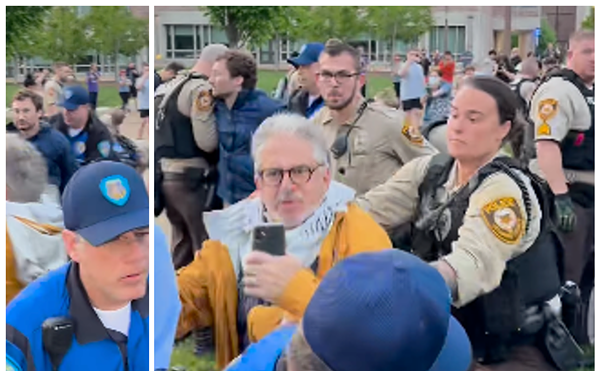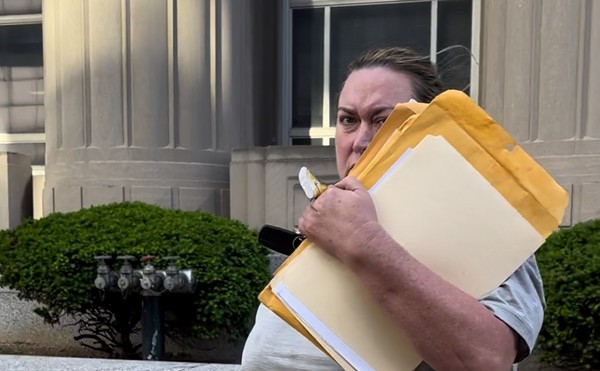"It takes me through the whole day," exults the 43-year-old father of six. "Everyone looks at me now and they see a glowing man."
Mason peddled marijuana in his Fairground Park neighborhood from the time he was thirteen years old. He didn't become a full-time pusher until he turned 30, around the time he got caught in gang crossfire and lost his lower left leg. Still Mason kept at it. Selling drugs was more lucrative, and less painful, he explains, than a nine-to-five job.
"I could stand out there for only three hours and make five hundred dollars."
In March 2002, Mason was arrested for possession of more than 35 grams of a controlled substance. He pleaded guilty in St. Louis Circuit Court and was placed on probation for two years.
"And like a knucklehead, I went right back up there a month later and got caught again," he laments. "I went to prison for a whole year."
Upon his release in 2004, Mason set about satisfying the probation requirements from his first offense. Along with a twelve-step drug program and GED classes, St. Louis Circuit Court Judge Philip Heagney ordered Mason to the enigmatic-sounding Enlightened Sentencing Project to learn Transcendental Meditation.
"I'm a dude that's stubborn, bullheaded, and when I went to that first meeting, I wanted nothing to do with it," Mason admits. "But meditation saved my life, man. I swear to you."
Transcendental Meditation, or TM, is a stress-reduction technique developed 50 years ago by Maharishi Mahesh Yogi, an Indian spiritual leader. Popularized by the Beatles in the 1960s, the teachings of the Maharishi are now followed by more than six million practitioners worldwide.
Twice a day, they sit with their eyes closed and repeat a silent mantra for twenty minutes, entering a state where the mind is alert, while the body reaches a relaxing realm deeper than sleep. The practice has been medically proven to enhance mental health, and reduce hypertension and blood pressure.
TM has gained traction in the past ten years, with several U.S. schools reporting that students are less violent and more focused after meditating. Last year, the movie and television director David Lynch founded the Hollywood-based David Lynch Foundation for Consciousness-based Education and World Peace, with plans to underwrite university classes in TM and provide startup funds to elementary schools looking to establish programs.
Using TM to rehabilitate convicted felons has proved a much harder sell. Bombay-born Farrokh Anklesaria, a British-trained barrister, took up the crusade in 1980 and, in April 1996 began teaching the program in St. Louis — the only city in the nation offering this kind of treatment for convicted felons.
"The technique is not religious, but I do have a missionary zeal about it," says Anklesaria. "I don't care whether a guy is a murderer, a wifebeater, whatever. I teach him the method. Ultimately, you have a man whose physiology is incapable of crime."
Anklesaria, who learned TM from the Maharishi, established programs in prisons in Sri Lanka, India and Senegal, at the guru's behest. In the early 1990s he began lobbying U.S. corrections officials.
TM wasn't completely unknown stateside. In fact, 150 inmates at California's Folsom State Prison meditated in the late 1970s. Researchers at the Fairfield, Iowa-based Maharishi University of Management later tracked the parolees and found that their risk of reoffending was reduced by 44 percent.
Still Anklesaria failed to sway state prison directors in six different states. "When I pointed out to the California wardens that for every dollar invested in this program they would save twelve dollars, their answer was, 'Where do I get the one dollar now?'"
Anklesaria's fate changed when he introduced St. Louis Circuit Court Judge David Mason (no relation to Keith Mason) to TM at a 1995 conference in St. Louis.
"When I became a judge there was one thing that weighed heavily on my mind," recalls Judge Mason. "How is it that I grew up in the same severe impoverished circles that some people coming in front of me grew up under, but I was able to deal with them, get through school, and to where I am? I didn't have any extras. I didn't even have a father. I had a mother with an alcoholism problem. What was the difference?"
Anklesaria teaches TM to felons whose offenses include drug possession, assault, child abuse and armed robbery. The two-hour classes, which begin with ten minutes of yoga, are held on Tuesday and Thursday evenings at the Centenary United Methodist Church in downtown St. Louis. More than 250 probationers have graduated from the 26-session program.
"If we had the proper funding, we could touch thousands more," says Anklesaria. "Already, we have a couple hundred people on our waiting list."
Like many rehabilitation projects, the Enlightened Sentencing Project has no funds to conduct recidivism studies. (Anklesaria charges $200 for the class, but operates primarily from private donations.) Neither Anklesaria nor the courts keep track of how many offenders sentenced to the program failed to complete it.
Anecdotal testimony from judges, probation officers and graduates is overwhelmingly positive.
"When I got into this class, all the cigarettes, the weed, the alcohol, everything disappeared from my life, and it wasn't even conscious," says graduate Tyron Henry. "Suddenly you realize you're watching a football game and you don't have a beer next to you, and you're like, wait a minute — something's happened here!"
Says Mason: "Of the more than a hundred I've sentenced, maybe three or four have come back in front of me."
Today five state and federal judges in Missouri sentence probationers to the Enlightened Sentencing Project, which has also been embraced by State Supreme Court Justice Michael Wolff.
Can TM even rehabilitate murderers?
"It would be extraordinary to say we could fix that kind of person," replies Wolff. "But at the lower levels of crime, we really ought to be thinking about how to fix people, how to fix ourselves, because sooner or later the people committing these crimes are going to come back into our community."
If Anklesaria had his way, the Missouri Department of Corrections would allow him to teach the method in a maximum-security prison. "It would become absolutely apparent as night is from day that the meditating population would show significant improvements in recidivism."
It's a bold wager, says Beth Huebner, assistant professor of criminology at the University of Missouri-St. Louis. "That would probably not play too well. Taxpayers want criminals to be punished."
TM devotee Keith Mason, who finished the class last August, says he'd be the first to help Anklesaria teach, should the program ever get enough resources to expand.
"I learned patience," says Mason. "My temper ain't bad no more, and I can do things I couldn't do, like get up and walk. I can walk without my cane. I don't even take any more pain medication for my leg."





